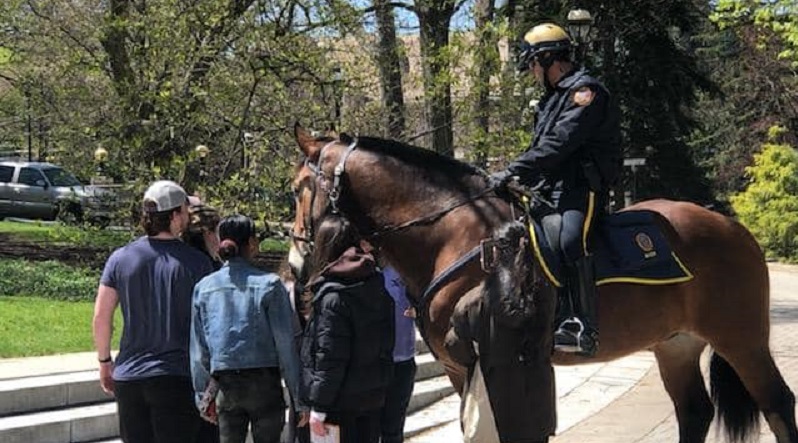
I recently observed a farrier replacing horseshoes for a police-certified equine member of a metropolitan police force. I got to thinking about the role these beautiful animals fill among American law enforcement agencies.
Much like police canines possessing super-sensory capacity and unceasing vigor with certain skills human counterparts admire and respect, horses trained for various duties employed by mounted units have select qualities enabled by their very species.
My first experience witnessing police horses was in New York City’s Central Park, with all its meandering streets, various lakes, and rolling hills inviting people to enjoy the plein air environment smack dab in the middle of Manhattan, it made sense to see horses and hear them klip-klop while pulling carriages occupied by tourists or regulars indulging in hands-free navigation.
As a young boy aspiring to be a policeman, though, I admired the NYPD cops riding horseback—in Central Park and elsewhere.
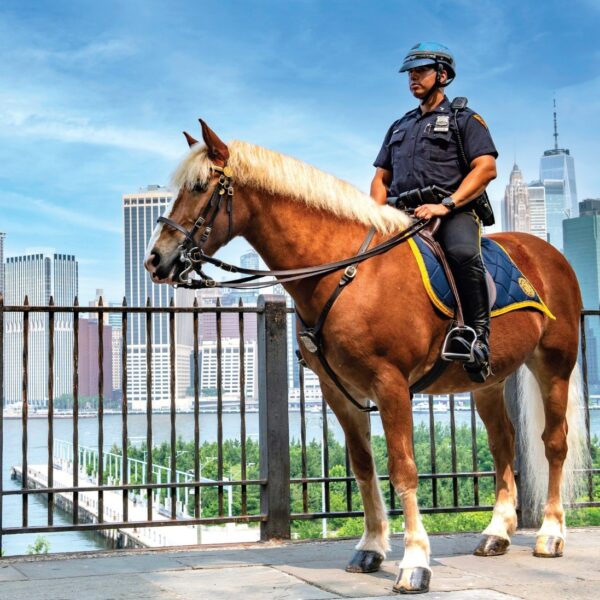
(Photo courtesy of the New York City Police Department.)
For the cop riding the police horse, it provided an aerial view of the landscape and the many people who use it throughout the year (with many nefarious types among them, preying on innocents trying to enjoy nature).
Back in the day, the NYPD housed and cared for many of their horses in a stable-like setting in Central Park. On several occasions, I scored the thrills of talking to NYPD cops and up-close interactions with police horses. Seeing me in their eyes always stood out. Watching their nostrils flair, hearing their grunts and neighs, the clanks of their bits when they seemingly nodded (I assumed at me, an amused kid and cop-wannabe), that squeaky-new creak of horse tack and saddling against the NYPD cops’ leather high-top boots.
A crowd always formed, drawn in by fascination of a massive yet poised animal.
And that is a primary patrol ingredient of police horses: public relations. Even though I have not spent tons of time around horses, I’ve never seen anyone turn away from the presence of one.
It is said the NYPD horses get more attention than the Kardashians.
The super-sensory capacity of horses…and training…and co-reliance? That and a whole lot more! Check out this brief footage:
There are always police-mounted horses in NYC’s Times Square, guaranteed. Horses grab attention and garner respect. And, yes, they are certified police officers.
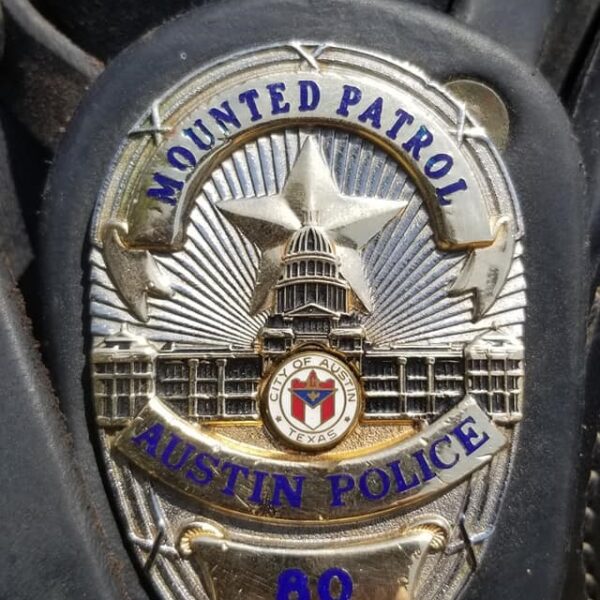
(Photo courtesy of the Austin Police Department.)
Piggybacking on the public relations benefits of police horses, also aligned with that is the LEO rider who marvels that special bond our species enjoys with animals. Ask any police canine handler any question about his/her canine partner, and you will receive a varietal answer punctuated by best buddy sentiments. Invariably, though, the human counterparts value these animals for the way the community receives them, as sources of therapy and widespread appeal:
As you just heard, horses give a whole different meaning to “Will work for food,” not much different than police canines which work for treats (rewards) and/or fave toys, all for doing an extremely dangerous job.
Police horses cater enormously to ever-burgeoning stress in LEOs; just like street-duty or therapy dogs, horses help offset burdens caked on by the myriad perils of being a police officer.
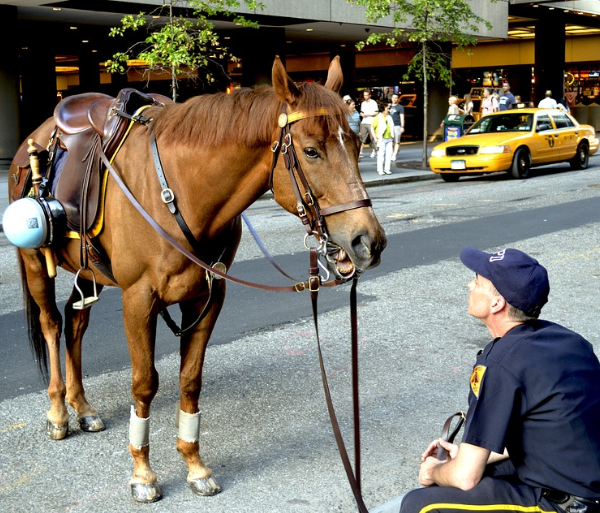
(Photo courtesy of Pixabay.)
This photo illustrates that police horses have a special way of helping human partners de-stress, right there in the heart of a metropolis. Horses help anyone in the same fashion but for different reasons. Expanding on that, several comments I located regarding the calmness and aura and magnetism of horses provide food for thought, beyond the grains of imagination:
Keletube offered: “I heard a case where a criminal was detained and a pet the horse and because of his comfort level with the horse, he released a crazy amount of information to the officer. Another officer on horseback pursued a criminal and because he was so high up could give specific information as to where he was running and helped detain him. They are a very valuable patrol.”
Nancy in the Garden said, “I was raised on Race n 63rd in West Phila. They were always in the park and all police were friendly and knowledgeable with us kids. Felt much protection from predators in the park any time of the day. That was bk in the late sixties when predators were quietly prevalent but still around and ready to abuse us kids. I’m one of nine and one of us were always coming home with someone approached them. It’s not even a choice not to have police in the communities. Thank you for all the good you do to keep us safe and others straight.”
As we just covered, horses have a way of influencing respect and adoration by mere presence. In that scope, mounted unit training includes employing the animal as a viable ambassador policing the community. On the malevolent end of the spectrum, police horses serve as portable barriers when a victim of crime is in need of a safety zone while other foot patrol cops provide medical aid to the injured citizen and maintain the crime scene (antagonists heed horses better than yellow tape).
The Indianapolis Metropolitan Police Department posed it this way: “Police horses make for excellent ‘moving walls’ capable of ushering large crowds, or if necessary, a horse can side-step alongside a single person or small group to separate them. Officers also enjoy a high vantage point up to 10 feet above the vantage of other people or officers. This allows officers to see more people and for more people to see them.” Thus, the value of visual deterrents.
Mounted Police units are a relatively stratified feature among law enforcement agencies around the globe, largely used in the same fashions as other law enforcement entities.
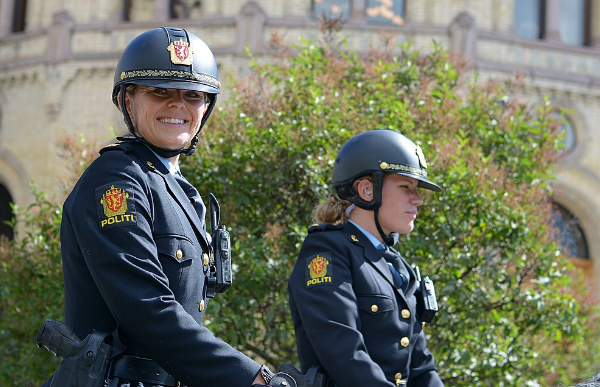
(Photo courtesy of Pixabay.)
Generally, officers who wish to join the mounted patrol unit often possess experience riding these beauties. That is not to say LEOs inexperienced in riding a police horse are automatically excluded—new skills can be learned and scoring a role as a mounted cop can be accomplished.
As with other specialty units, criteria vary among different police agencies; some candidates may be required to already have demonstrable skillsets required for a certain unit while others may be granted some leeway to personally build up the basics (general horse-riding schools) as the recruitment process continues.
Launched in 2011, the Sacramento Police Mounted Unit is fairly new (given the antiquity of other established mounted patrol units). One of their initial candidates explained novice but was brought up to snuff with “in-house training” provided by more experienced police officers with equine knowledge and ridership skills.
As with any police certifications, the respective state’s Criminal Justice Standards and Training Commission (CJSTC) board set the requirements for each candidate in every facet of law enforcement proficiency.
Formally, there are accredited mounted police training academies that “provide [officers] the level of expertise and effectiveness necessary to get the job done” via a “curriculum based on quality, safety and the most current training methods in the market” ordinarily taught by active and retired police personnel well-versed in equine culture and law enforcement strategies.
As Philly police officer and Mounted Unit horse trainer Dave Toth explains, “This is probably the hardest unit in the police department to become good at. It’s a multitude of personalities working with horses. We all take a little bit of a beating in training and working with them but also working with a great group of people.”
Overseeing his department’s Mounted Patrol Unit, Philadelphia Police Lt. Joseph McBride shared this fundamental principle with us, “The kind of officers that’ll come to Mounted Patrol are ones that enjoy working with animals and ones that are community-relations oriented.”
Even though our PD did not have horses, most police officers I’ve ever worked with in our department’s police canine unit were either former military working dog handlers and/or civilian dog trainers marketing duty-ready canines to law enforcement agencies. Naturally, experience carries more viability amid competition for a select few slots. It would have been the same perspective if we were to originate a mounted unit.
But it’s not only about the prospective police officer riding atop the horse that makes the grade. It is also about the animal…
According to Cowgirl Magazine, ”Even in chaos, police horses remain calm and focused on their job!”
Emily Fought explained: “Gun shots, irate people, and zooming traffic are just a few of the things a police horse will encounter while on the job. These horses are able to remain calm and focused on their mission, which is to protect and serve the people. While many of these horses are born with quieter temperaments, the reality is most of their calmness is trained!
“Through extensive training, police horses develop the skills necessary to patrol the streets. They are taken through various obstacles that prepare them for real-world experiences.”
Check out this brief video from the Philadelphia PD, explaining their Mounted Unit’s history, multi-use, selection criteria for assignment, and training regimen among the specialized team:
I respect the notion of police horses being viewed as “ice breakers,” whereby citizens observe the animal, revere its large size and regal nature, in turn serving as a catalyst to bring cops and community together.
Although the ice-breaker connotation is grand, another use of police horses is more on the somber side, but with honor and respect: The riderless horse.
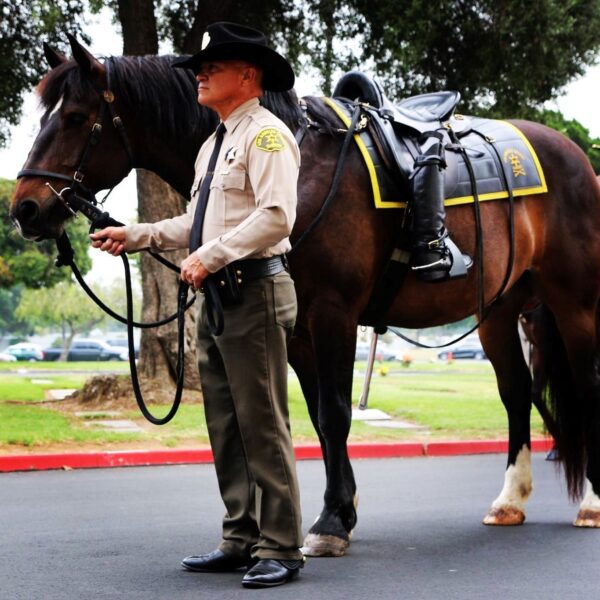
(Photo courtesy of Friends of Antelope Valley Volunteer Posse.)
I’ve never physically attended or virtually viewed a police funeral where a riderless horse was not depicted to convey the depth of honor toward law enforcement officials fallen in the line of duty.
Parades and festive venues and mass-scale events (political conventions) in jurisdictions that have mounted patrol units will invariably have their equine cops involved in leading the pack in public relations presence or crowd control (when the feisty grow in number, neglect civility, and get downright criminal).
In any event, horses serve a multitude of purposes in police ranks. Overall, horses on patrol offer diversity in police applications of public safety and stand tall as ideal community relations members aka “the ten-foot cop.”